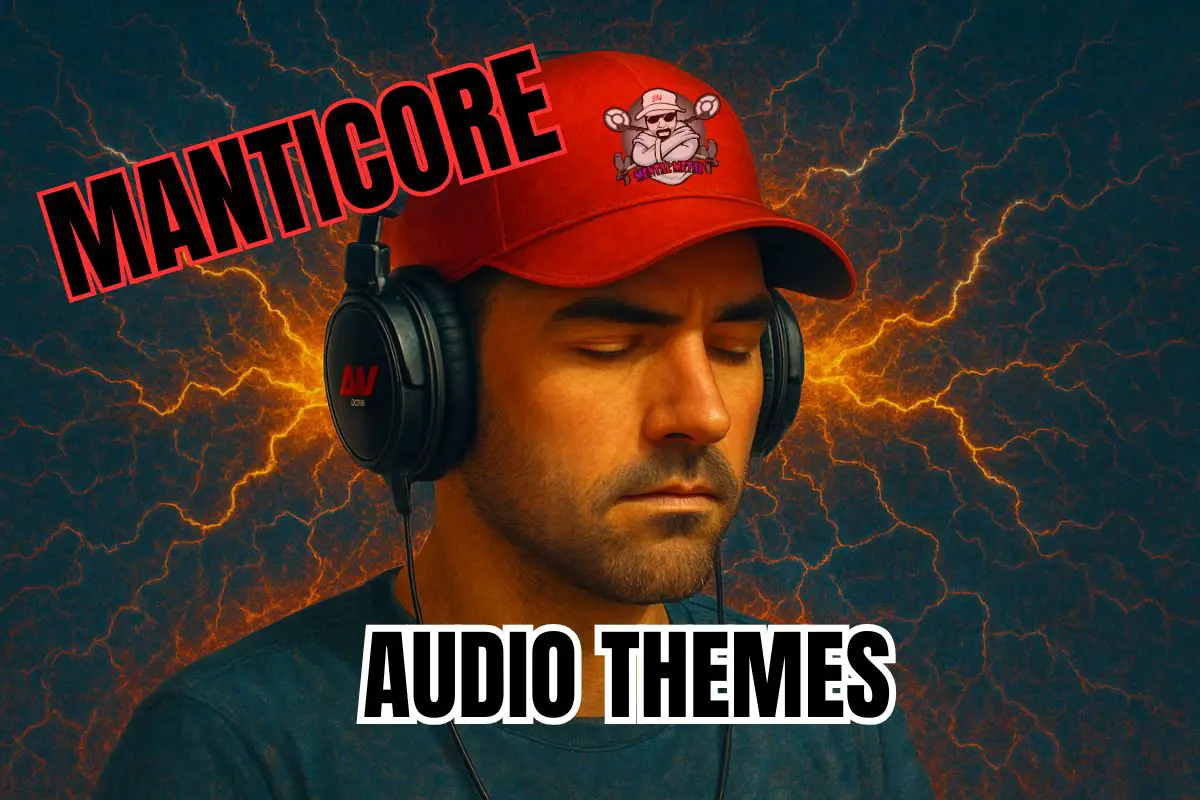Introduction: The Power of Audio Themes in Metal Detecting
The Minelab Manticore isn’t just advanced—it’s transformative. What truly elevates its performance is its customizable Audio Themes—modes that shape how the detector communicates a signal to your ears. Whether you’re navigating EMI-challenged cityscapes or hunting for tiny gold nuggets, dialing in the right theme gives you the edge. This guide walks you through all four themes—Normal, Enhanced, Depth, and Prospecting—highlighting how they work, when to use them, their unique advantages, and key settings to dial in.
1. Normal Audio Theme – Everyday Detecting Made Simple
What It Does
Normal Audio Theme is your go-to for general detecting. It delivers full-sounding audio responses that vary in both pitch and volume to reflect target characteristics.
- Pitch is driven by the Target ID (as defined in Target Tones).
- Volume scales with signal strength—stronger or shallower targets ring out louder; deeper or weaker ones offer softer tones.
Strengths
- Balanced and intuitive: gives clear audio feedback across most terrains.
- Great starting point for beginners learning tone differences.
- Default setting across search modes for a reason.
When to Use It
- Everyday detecting with mixed targets in low‑interference environments.
- Parks, fields, and general beach hunts where versatility matters.
- As a baseline for audio training—understand the tonal language before exploring specialized modes.
2. Enhanced Audio Theme – Tackling EMI & Noise
What It Does
Enhanced Audio Theme is designed for noisy environments rife with EMI—like near power lines, transformers, or in mineralized soil areas.
- Chatter from EMI becomes “thin” or “tinny,” whereas genuine signals sound solid and more prominent.
- Pitch stays tied to Target ID; you can adjust the Profile to manage how audio modulates.
Strengths
- Suppresses false chatter so you can confidently increase sensitivity.
- Helps interpret weak but consistent signals buried under noise.
When to Use It
- Urban sites or industrial zones with heavy electrical interference.
- Mineral‑rich areas where background noise often obscures faint targets.
- When trying to hear subtle targets without being drowned out by environmental chatter.
3. Depth Audio Theme – Sorting Depth & Ferrous Clutter
What It Does
Depth Audio Theme shifts the sound approach—pitch is no longer tied to Target ID but varies by signal strength (depth). Non-ferrous targets climb in pitch as they get stronger/shallow; ferrous always remains low.
Selectable pitch ranges (1–64) for non‑ferrous targets and ferrous separately let you fine‑tune tone separation.
Strengths
- Exceptional distinction between shallow iron junk versus deeper, cleaner targets.
- Offers depth clues via tone—low = deep, high = shallow.
- Ferrous always sounds low, minimizing wasted digs.
When to Use It
- Land sites overloaded with ferrous clutter—fields, old homesteads, playgrounds.
- Historic areas where depth discrimination is essential.
- When you want audio feedback that prioritizes depth over ID.
4. Prospecting Audio Theme – Ultimate Sensitivity for Faint Targets
What It Does
Prospecting Audio Theme pushes sensitivity to the max. It echoes signal strength, not ID—and disables Target Tones altogether.
You can turn off ferrous tones entirely—so weak non‑ferrous signals won’t be masked by iron. The theme uses a True Threshold Tone, tuning you in to even the faintest whispers.
Strengths
- Ideal for gold prospecting—tiny nuggets or delicate jewelry on beaches or black sand.
- Ferrous silence allows micro-targets to stand out.
- Maximizes threshold temporal clarity for the subtlest signals.
When to Use It
- Goldfields and mineral-rich soils where targets are minute.
- Beaches or low-trash environments where even faint signals matter.
- When you need to isolate ultra-faint and delicate targets that other modes might miss.
Quick Comparison Table
| Audio Theme | Best For | Pitch Behavior | Key Benefit |
|---|---|---|---|
| Normal | Everyday detection | Target ID‑based pitch, volume scaled | Balanced, beginner-friendly versatility |
| Enhanced | EMI or mineral noise areas | Target ID pitch, “tinny” EMI tones | Suppressed chatter, clearer weak targets |
| Depth | Ferrous‑cluttered inland sites | Signal strength pitch, depth cues | Depth discrimination, iron separation |
| Prospecting | Gold & fine-target recovery | Signal strength, ferrous muted | Ultra‑sensitive detection of faint clues |
Tips to Maximize Each Audio Theme
- Start with Normal—it’s the foundation. Learn how signals sound before exploring other modes.
- Use Headphones for subtle tonal differences—key for Depth and Prospecting modes.
- Profile Tuning—Simple, Medium, or Rich adjust how much pitch/volume changes with signal strength or depth. I typically stay in the Medium profile.
- Threshold Control—keep it just above silence to catch faint targets without noise. Adjust Threshold Level/Pitch according to theme.
- Switch Smart—don’t hesitate to change audio themes mid-session as conditions shift.
Final Thoughts: Master the Modes, Master Your Finds
The Minelab Manticore’s audio themes are more than just settings—they’re your advantage in the field. Start with Normal for training and general hunts. Switch to Enhanced when EMI or interference challenges your clarity. Use Depth to separate targets by depth and ferrous clutter, and unleash Prospecting when chasing that faint glimmer of gold or jewelry.
Each theme brings a unique strength—learn them, experiment, and adapt. Soon, you’ll hear what others miss.
Looking for a Great Deal on a Minelab Manticore?
f you are looking for the Minelab Manticore, you can find them over at Fort Bedford Metal Detectors. They offer fair and competitive pricing with great service and support. Give them a chance to earn our business but make sure you tell them Scott from Mental Metal Detecting referred you. Give them a call directly at 1-814-215-1732.

Join Me on Patreon!
Unlock exclusive behind-the-scenes content, tips, and discoveries from my metal detecting adventures by joining the Mental Metal Detecting Patreon! As a supporter, you’ll get early access to videos, members-only tutorials, and insider updates on my hunts for relics, coins, and treasure. Your support helps keep the channel going and gives you a direct line to shape future content. Come be part of the treasure-hunting community and help uncover history, one signal at a time!

Mental Metal Detecting is a proud participant in the Amazon Services LLC Associates Program, an affiliate advertising program designed to provide a means for sites to earn advertising fees by advertising and linking to Amazon.com. Mental Metal Detecting also participates in affiliate programs with Bluehost, ShareASale, Fiverr, and other sites. Mental Metal Detecting is compensated for referring traffic and business to these companies.

